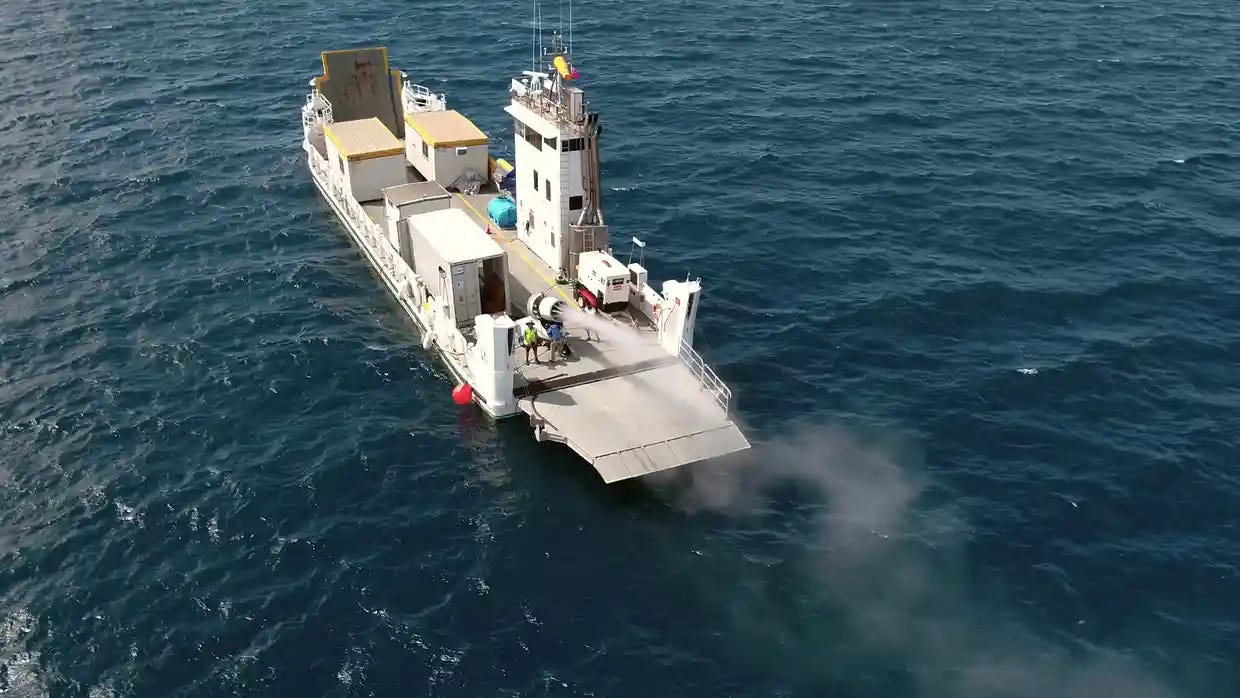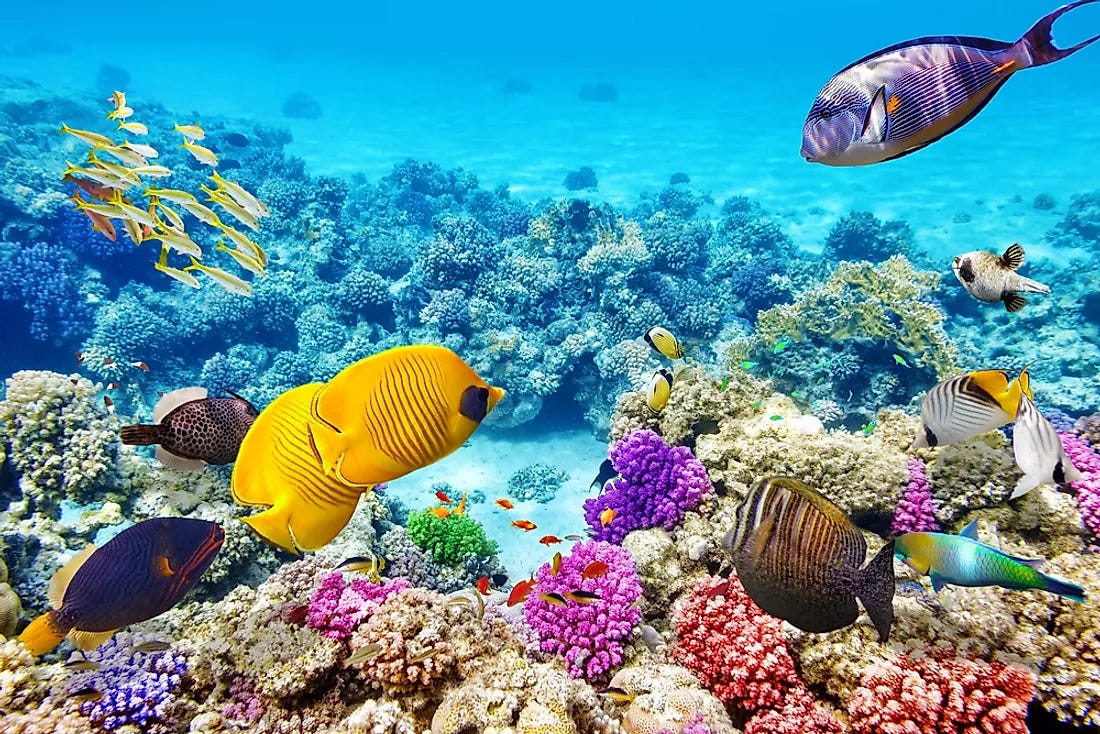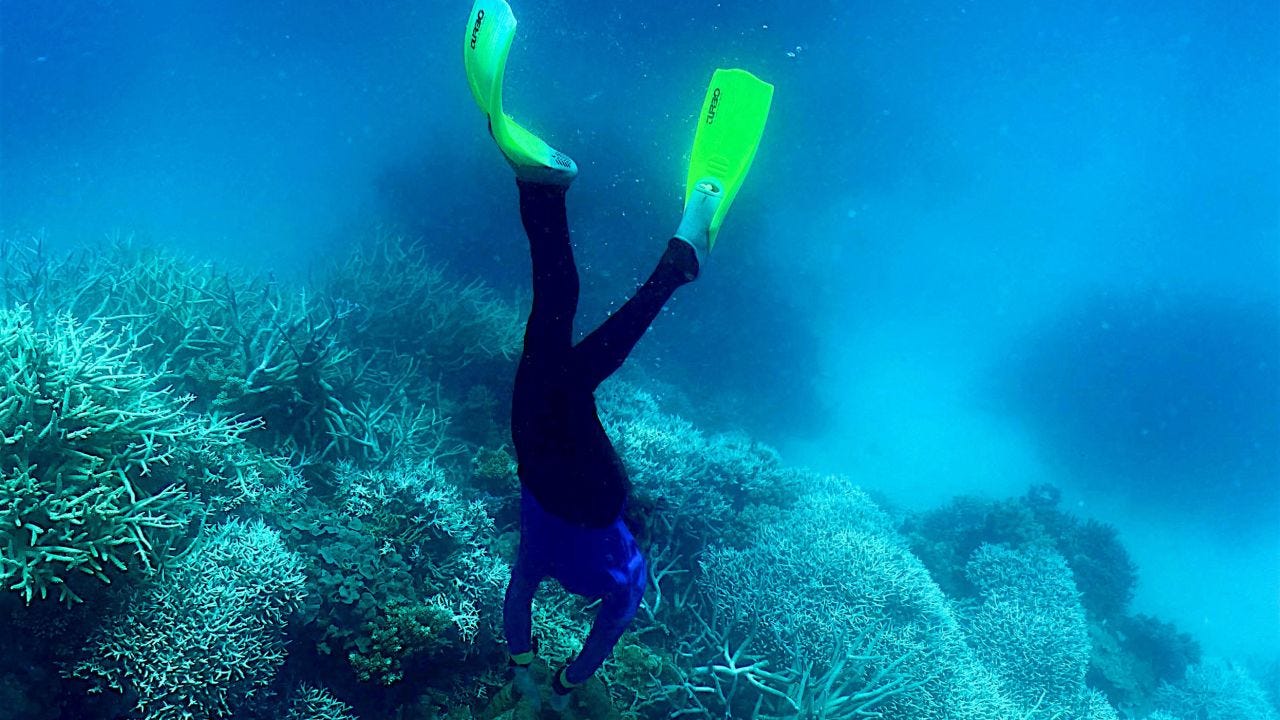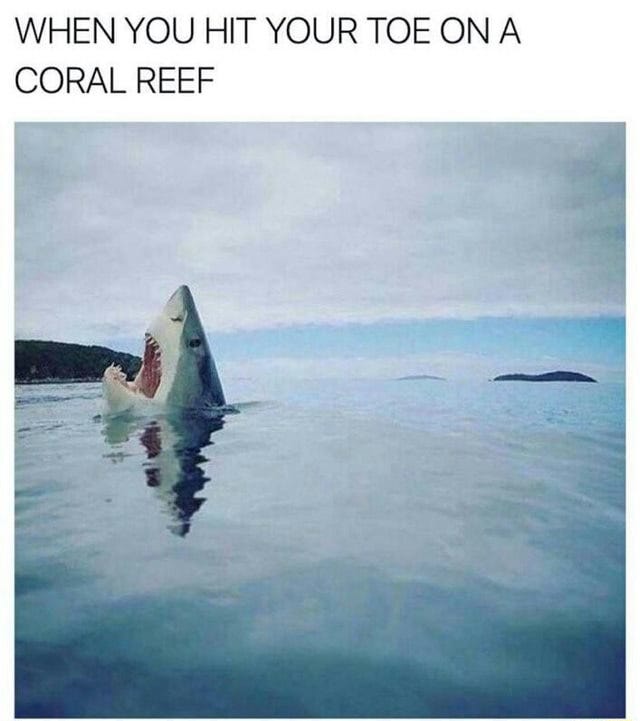Throwing (reef) shade
Can we stop "to bleach or not to bleach" from being the question?
“People say, what was the most magical moment in your career as a naturalist? And I always reply: 'The first time I put on a mask and went below the surface [on the Great Barrier Reef] ... An extraordinary experience, like going into space — such splendor: all of these things moving through an architecture of coral. There's no equivalent anywhere else in the natural world.”
Sir David Attenborough
June 1st was the third annual World Reef Day. Even if you follow ocean news closely you likely didn’t see any celebrations of corals. This lack of attention is even more frustrating considering that the Great Barrier Reef, the world’s largest and most famous undersea ecosystem, experienced a massive bleaching event earlier this year. It’s the sixth to hit the Reef since 1998 and the fourth in the last six years. With everything else going wrong in the world, the media deliberately chose not to cover another ‘disaster’ — and in doing so missed an opportunity to explain a very ~cool~ geoengineering technique called reef shading.
You’d be forgiven for not realizing that corals are animals, not plants; after all, these invertebrates do not have any ecological or corporeal charisma. They look different from the little beings we see every day, and unless we live within the latitudes 30° north and 30° south (or on a tropical island) we’re inclined to forget about them altogether. Yet when you read the word ‘coral,’ an image no doubt appears in your mind. Corals are colorful and intricate beings; they possess a unique beauty, which gives them aesthetic charisma. Reminders of the threats to their existence revives our emotional connection to stopping climate change, for how could we let something so beautiful be lost?
Even though this post is a few days late, let’s celebrate our corals by studying Australia’s Great Barrier Reef (GBR) and learning about what governments, scientists and even tourists are doing to protect it.
For an in-depth refresher on what corals are and the basics of bleaching, check out my previous post:
Essentially, coral reefs are comprised of thousands of individual organisms called polyps, which have a symbiotic relationship with the algae species zooxanthellae. When waters are warmer, sunnier, or more acidic than usual, the corals become too stressed to eat or breath and expel their zooxanthellae. Without the algae, the coral loses its main food (and color) source and becomes more susceptible to disease. The longer waters remain hotter or more acidic than normal, the longer a coral will be stressed. Additionally, ocean acidification causes shells made of calcium carbonate to disintegrate. When coral polyps have neither food source nor a strong skeletal home, they are more vulnerable to disease, predation, and death. Per the IPCC Report, if the earth’s temperature increases beyond 1.5°C, the earth will lose 70-90% of its corals; this number increases to 99% if we hit 2°C warming.
Case study: the Great Barrier Reef
Made up of nearly 3,000 individual reefs, the Great Barrier Reef (GBR) is the largest living structure on the planet and has been on the list of UNESCO Wonders of the Natural World since 1981. It protects the coastline (hence why it is considered a barrier reef) of a territory in Northeast Australia called Queensland. The Reef is home to 25% of the world’s marine species, including six of the seven types of turtles. Climate-wise, the GBR is one of the largest carbon sinks in the world. Its mangrove groves and seagrass beds absorb and store CO2 from the atmosphere, which helps mollify the effects of climate change. Additionally, the Reef attracts more than two million tourists a year, contributing $6.4 billion to Australia’s economy and supporting tens of thousands of jobs.
The GBR is currently recovering from an intense bleaching event. Australian scientists became worried when ocean temperatures rose to record high levels — 1 to 2°C above average — in December 2021 (remember, Southern Hemisphere’s summer begins on December 21st!). Since water has a high specific heat capacity, it takes a while for any heat absorption to become observable — meaning the effects of extreme temperatures in December did not surface until much later. The level of heat stress in the Reef peaks in March each year, just before the environment starts experiencing cooler, autumnal temperatures.
It should be noted that bleaching events differ from mass bleaching events. Individual corals can and will bleach when stressed, but when an entire colony (or entire reef) expels their zooxanthellae it devastates the ecosystem. Species diversity within reef ecosystems can decrease because of indigenous animals relocating to other reefs and less habitat-specific animals taking their place. Think of it like this: if you neglect to water your lawn & plant grass seed every spring, weeds like dandelions will grow under the conditions that have become too harsh for grass.
To Bleach…

The Great Barrier Reef experienced large-scale bleaching events in 1998, 2002, 2016, 2017, and 2020. The last 3 of these episodes corresponded with extreme temperatures. Three weeks ago, the Great Barrier Reef Marine Park Authority confirmed that the largest threats to the GBR this past (Australian) summer were three marine heat waves, which resulted in 91% of corals bleaching by March 2022. Marine heat waves are 5 consecutive days when sea surface temperatures register above 90% of previously recorded highs (aka extreme heat in the water). Between 1981 and 2017, marine heatwaves increased more than 20-fold due to climate change. Crucially, a temperature increase of just one degree Celsius for only four weeks can trigger bleaching; if high water temperatures persist for eight weeks or more, most corals begin to die. Scientists can predict the likelihood of a bleaching event by measuring how long sea surface temperatures will be at least 1°C above average. This is called a Degree Heat Week (DHW) — the system is like weather forecasting but measures sea surface instead of atmospheric temperatures.
El Niño’s are sometimes responsible for this excess heat: in 2015-2016, an unusually strong El Niño caused 70% of all oceans to experience heat waves. Notably, 2022’s bleaching event is the first to happen during a La Niña year when conditions are typically cooler and milder. Furthermore, the time between severe bleaching events has diminished steadily since 1980. This return time is now 6 years and until now has been influenced by the warm phase of El Niño Southern Oscillation events (I’ll explain ENSO in detail in another newsletter).
Coral colonies can take up to eight months to recover from a single bleaching event, so the recovery period is currently ongoing. Indeed, scientists will not have an accurate assessment of how much coral was lost until October or November, so look out for articles at around that time. On the bright side, if waters cool back down enough, corals will again accept zooxanthellae back into their cells and the mortality rate will be quite low: this happened in summer 2020 when sea surface temperatures returned to normal fairly quickly. While species of corals that have less intricate structures are resilient enough to survive the bleaching, scientists worried that the increasing intensity, duration, and frequency of future marine heat waves will devastate the Reef.
…Or not to bleach?
Politically, the health of the Reef is a major issue. The Australian government has been under pressure from UNESCO to prove that it’s doing enough to save the reef, and the country has also been criticized for not doing enough to transition away from fossil fuels & cut greenhouse gas emissions. The government’s park authority runs a website that is supposed to post weekly updates about the health of the GBR, yet nothing has been published since April 22nd —almost two months ago. This reminds me of the ocean literacy website that went defunct years ago yet is still being referenced…! An overwhelming number of Australians believe that the government should protect and preserve the GBR, but Queensland is one of the world’s largest exporters of coal, which is mined and trafficked in and around the Reef.
Thankfully, in 2020 the Australian government allocated $150 million of funding to the Reef Restoration and Adaptation Program (RRAP) which involves 43 separate ways to help the reef mitigate, adapt to, and recover from climate change. The main method is reef shading, which is achieved by creating clouds, mists, fogs, or surface films to refract the solar irradiation. This lowers the intensity of the light and can help mitigate the heat levels of the water. Think of it like choosing to park your car under a tree instead of in the middle of a parking lot on a hot summer day: the Snickers stashed in your cupholder will still melt, but less drastically than if it were exposed to direct, continuous sunlight.

The most popular reef shading technique is marine cloud brightening: this is when salt crystals are sprayed into the air, allowing the already-present water vapor a particle on which to condense. These salty clouds form a low-lying fog, which help to refract sunlight so less penetrates the water. This is a natural process that mirrors what happens over the oceans every day as winds carry salty ocean spray into the air. This technique would only be employed as needed, such as when weather forecasts and DHW models predict corals will be under dangerous levels of heat stress. Other shading methods involve spreading ultra-thin reflective films that could temporarily cut the sunlight over small areas or increasing turbidity in the water.
Technically this is geoengineering: we humans are intentionally altering an ecosystem as opposed to indirectly affecting it via emissions and pollution. Australia’s RRAP has high hopes for reef shading, saying that it should be widely implemented or at the very least consistently deployed to the most vulnerable part of the GBR. Notably, their official website calls it as “eco-engineering,” a less-controversial word choice that is somewhat humorous to we in the know. Before deploying reef shading at a larger scale, the organization hopes to measure and model the GBR’s environment for four years.
It is not, however, a perfect solution. A continuous reduction in light prevents the zooxanthellae within the corals from photosynthesizing; this does not bode well for reef shading techniques. Corals can bounce back from occasional loss of sunlight, but any prolonged efforts might do more harm than good. And although the technique has been around for decades, there is a significant dearth of information in scientific journals. When searching “Great Barrier Reef reef shading” on Google Scholar, the most recent article was published six years ago — and a majority of the results were published last century. Reef shading is exciting in theory, but the handful of scholars who directly studied the technique in tropical environments did not report positive results. And yet, we are in a new era of science, one where the public is more interested than ever in pushing our natural boundaries. It is no longer enough to transplant heat-tolerant coral species can or even to genetically modify corals so that they can withstand warmer SSTs. Once coral reefs have crossed their tipping points, entire communities of marine life (not to mention the civilizations that depend on reefs for protection) will collapse. Human-induced climate change will continue to force ecosystems into abrupt and often irreversible change unless we take strong adaptation actions — actions like investing in geoengineering studies before employing them.
Public Benefactor No. 1?
According to the IPCC, bleaching and mass mortality of corals in the Reef have induced measurable ‘reef grief’ among reef visitors and researchers alike. This phenomenon is a type of solastalgia, or the longing for an environment that used to exist. Reef grief is humanity’s reaction to a loss of aesthetic charisma (no colors + weird shapes = disappointed tourists); this alone can cause people to disengage from conservation efforts. On the other hand, preventing bleaching is often used as a call-to-action by environmental groups to motivate the public to support reef restoration projects & to their natural beauty.
According to a June 2016 research paper, the GBR is predicted to lose 10,000 jobs as well as 1 million visitors per year because of mass bleaching events. Of those would-be tourists, over 17% may not come to Australia at all, meaning the government would lose $1 billion in revenue. This is likely why tourism officials avoid discussing the GBR’s problems. As a result, tourism continues in Queensland because of this deliberate lack of ocean literacy. Although over half of Australians believe the GBR to be in poor condition, only 30% of likely international travelers shared this opinion — and 20% said they didn’t know enough to be certain. Roughly 70% of foreigners surveyed said they had heard about coral bleaching in the context of the Reef BUT less than half correctly identified global warming as the cause. *facepalm*
A poll taken just two years after the 2016 bleaching event detail how the GBR went from #3 on the attraction list to #12 in the minds of Australian tourists. Instead of focusing on diving, some business owners have been pushing sailing or jet skiing, activities that allow visitors to experience the reef without looking too closely at the coral. However, this shift of focus has cut scientists & conservationists off from a very abundant, very eager resource. People want to experience the Great Barrier Reef, and by preventing tourists from visiting it (or only allowing them to see small parts of it) businesses & governments are stunting the growth of a new David Attenborough, who cited his first visit to the Reef as a pivotal moment in his career. Only 5-10% of the GBR is regularly surveyed, and nearly 7 in 10 areas of the Reef have never been explored. Thankfully a non-profit called the Citizens of the Great Barrier Reef is trying to fill this knowledge gap. Their project, entitled the Great Reef Census, revolves around tourism operators bringing people to previously ‘unknown’ parts of the Reef. While there, they can take pictures and samples on behalf of scientists — after all, there are 134,000 square miles to cover! Some businesses have even deployed underwater drones while others have asked visitors to plant coral fragments from nurseries & replace unrecovered corals. Their website even has a feature allowing armchair scientists to submit their own reef surveys after completing a dive or boat trip!
Citizen science initiatives likes this are excellent examples of science & tourism uniting their strengths to help our environment. Just like Audubon’s Climate Watch bird survey, the Great Reef Census is providing scientists with real-time information that will help catalog climate change’s impact on the GBR and provide lessons for others like it. By helping coral reefs to adapt, humans will protect not only an enormous carbon sink but also an irreplaceable amount of biodiversity. Instead of focusing on the very real danger of losing the Great Barrier Reef, we can instead embrace the power we have to make positive changes to our world. Involving regular human beings in reef conservation demonstrates just how much good we can do.
Sources






